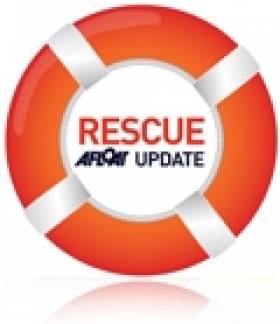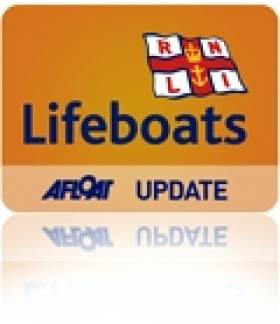Displaying items by tag: motor cruiser
Sunken Motor Cruiser Forces Bangor Harbour Slipway Closure
A Notice to Mariners issued on 29th August by Bangor Harbour on Belfast Lough warns that the slipway in front of the Lifeboat house has been closed due to a sunken vessel.
On Wednesday night (26th August) the owners of a 27 ft approx Beneteau Antares reported while out fishing they had " hit something" and as they were taking on water took the boat back to their marina berth.
But the Marina staff inspection showed that it was actually sinking and so it was towed by the Harbour workboat, the Guillemot, to the slipway in front of the RNLI station. On arrival, it was virtually underwater and as two fire engines were unable to pump it out it was left secured to the jetty.
 A Bangor Harbour workboat towing the sinking vessel
A Bangor Harbour workboat towing the sinking vessel
Very strong winds on Friday (28th) blew the boat across the slipway against the Eisenhower Pier and the lifeboat was moved to a Marina berth.
 The sunken vessel alongside Bangor Harbour slipway jetty
The sunken vessel alongside Bangor Harbour slipway jetty
The Notice to Mariners states "The safety of Boat Owners, Paddle Boarders, Canoeists, Kayakers and Rowers who use the slipway is paramount. The slipway at Bangor Harbour is now closed. Bangor RNLI Lifeboat has been relocated to Bangor Marina – this is a temporary measure. The slipway will be reopened next week after the sunken vessel has been removed. Thank you for your cooperation".
More On Power Boat Fireball Off West Cork
#BOAT FIRE - The Irish Independent has more on the incident in which a motor cruiser caught fire off West Cork at the weekend, as previously reported on Afloat.ie.
Denis Ryan, a car dealer from Inishannon in Co Cork, says he is lucky to be alive after a sudden fire engulfed his power boat off the Seven Heads Peninsula on Saturday afternoon.
Ryan was piloting his boat alone in the waters near Courtmacsherry when the incident occurred, destroying the plastic-hulled vessel in a matter of minutes.
His immediate distress signal was picked up by the Naval Service vessel LE Niamh which was in the area at the time, and Ryan himself was quickly rescued from the water by a passing yachtsman.
Sunken Cruiser to be Lifted in Fenit
A Sealine motor cruiser that hit rocks in Tralee Bay early on Sunday morning on a run back from Ballydavid is due to be lifted on to Fenit pier this week. Eight people were rescued by Fenit lifeboat and the boat was towed into Fenit harbour where it is now lying on the bottom. Photos: Paul Dolan.


Related Safety posts
RNLI Lifeboats in Ireland
Safety News
Rescue News from RNLI Lifeboats in Ireland
Coast Guard News from Ireland
Water Safety News from Ireland
Marine Casualty Investigation Board News
Marine Warnings
Two Men Die in Inishbofin Boating Accident
Two men died in a boating accident off the coast of Inishbofin in Co. Galway early this morning.
The pair, aged in their late 50's and early 60's had arrived on the island yesterday on a 40ft motor cruiser and it is understood, through local lifeboat sources, the accident appears to have happened as the two men returned to the cruiser by dinghy on Saturday night.
Both men were wearing lifejackets.
One of the bodies was washed ashore, while another was located inside the upturned dinghy around 11 o'clock this morning.
The bodies were airlifted by the Sligo-based Coastguard helicopter to Galway University Hospital.
Post-mortem examinations will be carried out to determine the exact cause of death.































































